Core Strength for Cycling, Part 1
A strong core provides a stable platform to anchor the leg muscles increasing power and supports the upper body reducing upper body fatigue.
by Coach John Hughes
John Hughes is the author of Anti-Aging: 12 Ways to You Can Slow the Aging Process and of the book Distance Cycling. He has written 40 articles on training, nutrition, psychology and medical issues for RoadBikeRider.com. More about Coach Hughes.
© John Hughes, All Rights Reserved
Strength training overview for endurance cyclists [ Part 1 |
Part 2
Recommended exercises for
- Increasing core strength [ Part 1 |
Part 2 ]
- Developing leg strength [ Part 1 |
Part 2 ]
- Improving muscle balance [ Part 1 |
Part 2 ]
- Strengthening connective tissues [ Part 1 |
Part 2 ]
- Improving upper body endurance [ Part 1 |
Part 2 ]
Benefits of Core Strength Training
Want to increase your power? Ever had a sore back or hands on a ride? Working on your core strength over the winter will help! A strong core provides a stable platform to anchor the leg muscles, increasing power, and supports the upper body, reducing upper body fatigue. Core strength doesn’t mean lots of crunches—these develop the superficial abdominal muscles but don’t provide core stability. Rather you need to strengthen the deeper muscles that form a girdle around your core. Your legs act like levers and a strong core provides a fixed fulcrum around which the upper legs pivot—more power to the pedals! A strong core will also support your upper body relieving fatigue in your lower back, shoulders, arms and hands. Your core should be strong enough that your hands rest lightly on the bars like you are typing!
The surface muscles you use for crunches (flexion) run up and down your abdomen; similarly the surface muscles you use for arching your back (extension) run up and down your back. Below the surface muscles are the core muscles, which run around your body, the transversus abdominus and the multifidus. These muscles form a girdle around your core, hold your back in neutral and provide a stable platform to anchor your leg muscles.
You want to activate and train the core muscles that run around the abdomen, not the surface muscles that run up and down. You can’t feel the core muscles working, their action is subtle. Here are several ways to visualize engaging them:
- imagine that you are pulling your belly button down to your anus
- imagine that you are tightening the muscles around your bladder and sphincter
- imagine that you are trying to make yourself thinner to slip sideways among people in a crowded room
- imagine that you are pulling on a tight pair of jeans
| |
| Pelvic Tilts: Lie on your back with your feet flat on floor. In a normal relaxed position there should be just enough room to slide one hand between your lower back and the floor. Place your hands on your stomach. Using your deep abs muscles flatten your back against the floor. Imagine that you are pulling your belly button to your spine. The motion is subtle—with your hands you should feel your abdomen tighten slightly. Then relax. Do these slowly and really work on flattening your back. Repeat 50 to 100 times. |
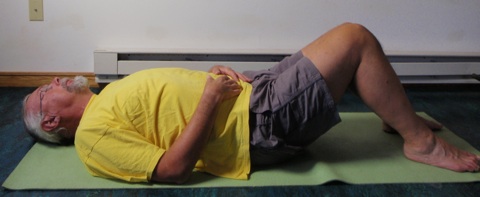
Start of pelvic tilt core training.
Back in normal relaxed,
slightly arched position. |
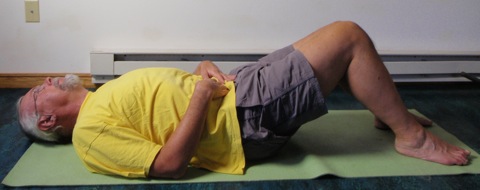
Finish of pelvic tilt.
Motion is subtle.
Abdomen contracts slightly. |
| Bent Leg Raise: Lie on your back with your knees bent about 90 degrees and feet flat on the floor. Tighten your abs and back muscles so your back is in neutral and immovable. Slowly raise your right foot off the floor about 6" and lower without moving your stomach or back. The key is to keep your core steady and immovable, even while moving your leg. Three sets of 10 to 20 reps with each foot.
|
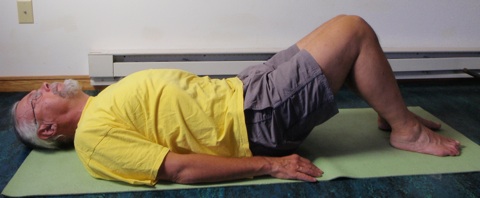
Start of bent leg raise core training.
Abdominal muscles engaged like in
pelvic tilt to stabilize core. |
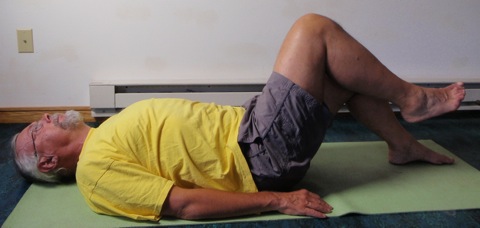
Finish of bent leg raise.
Leg is raised without
moving abdomen. |
| Straight Leg Raise: Lie on your back with your legs straight along the floor. Tighten your abs and back muscles so your back is in neutral and immovable. Slowly raise your right foot off the floor about 6", and lower without moving your back. Three sets of 10 to 20 reps with each foot. |
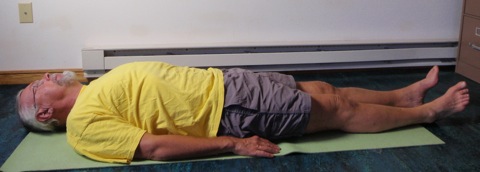
Start of straight leg raise core training.
Abdominal muscles engaged like in
pelvic tilt to stabilize core. |
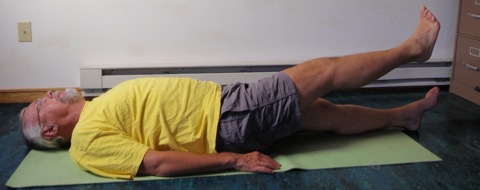
Finish of straight leg raise.
Leg is raised without
moving the abdomen. |
| Bent Two Leg Raise: Lie on your back with your legs straight along the floor. Tighten your abs and back muscles so your back is in neutral and immovable. Raise both feet off the floor until your hips and knees are bent roughly at right angles as if you were sitting in a chair. Lower your legs a few inches and raise them again while keeping your core steady and immovable. Three sets of 10 to 20 reps. |
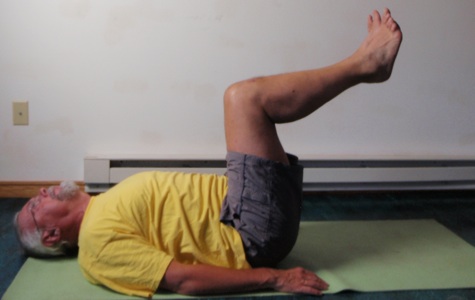
Start of bent two leg raise core training.
Abdominal muscles engaged to stabilize core. |
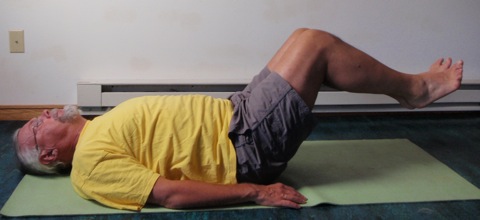
Finish of bent two leg raise.
Legs are lowered without
moving the abdomen. |
Straight Two Leg Balance: Lie on your back with your legs straight along the floor. Tighten your abs and back muscles so your back is in neutral and immovable. Raise both legs until they are straight and pointing at the ceiling. Now the work begins!
Move your right foot out to the side slightly and back without moving your left leg, while keeping your core steady and immovable. Do 10 to 20 reps with the right foot and 10 to 20 reps with the left foot. Lower legs and rest for 15-30 seconds. Three sets of 10 to 20 reps with each foot. |
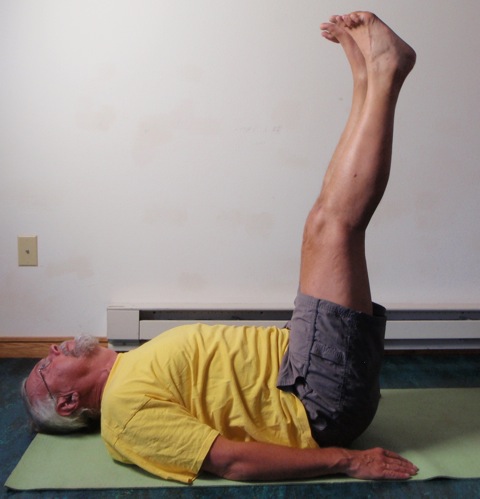
Start of straight two leg balance core
training. Abdominal muscles engaged
to stabilize core. |
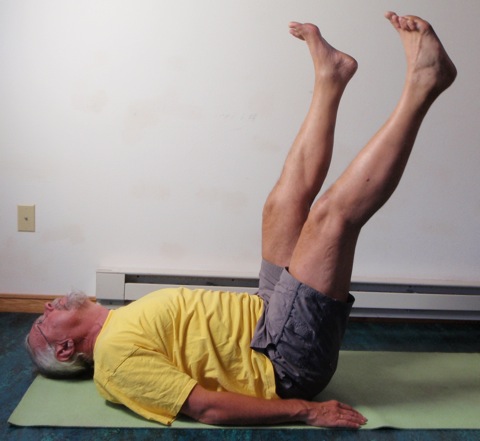
Finish of straight two leg balance.
Leg is moved out to the side without
moving the abdomen. |
Pilates Circles: Lie on your back with your legs straight along the floor. Tighten your abs and back muscles so your back is in neutral and immovable. Raise both legs until they are straight and roughly 45 to 60 degrees from the floor. The closer to the floor the harder the exercise. Now the work begins!
Make small clockwise circles with your right foot without moving your left leg, all the while keeping your core steady and immovable. Do 10 to 20 circles with the right foot, lower legs and rest for 15-30 seconds.
Raise legs again and make 10 - 20 small counterclockwise circles with the right foot, lower legs and rest for 15- 30 seconds.
Repeat with left leg doing 10 - 20 circles each direction. |
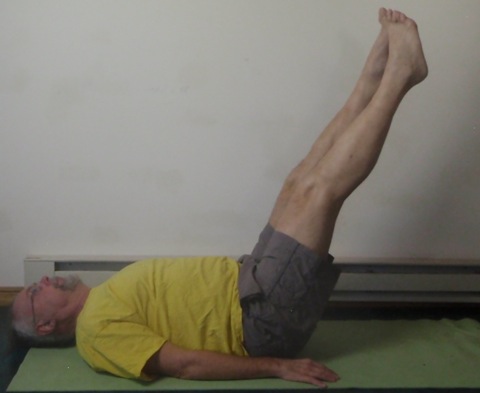
Start of Pilates circles core training.
Abdominal muscles engaged
to stabilize core. |
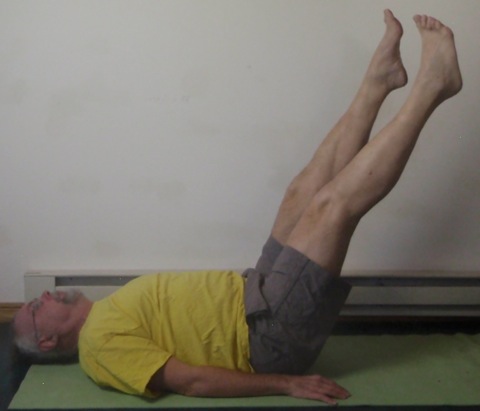
Finish of Pilates circles exercise.
Legs are lowered without
moving the abdomen. |
| Bridging: Lie on your back on the floor with your knees bent and your feet flat on the floor near your butt. Tighten your core muscles and then tighten your glutes (butt muscles) to raise your butt about 8 to 12 inches off the floor and lower. Three sets of 10 to 20 reps. |
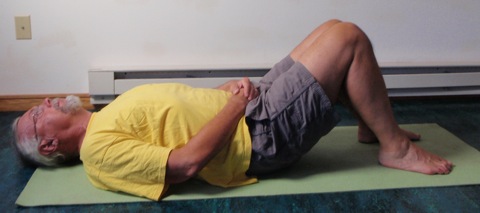
Start of the bridging exercise.
Abdominal muscles engaged
to stabilize core. |
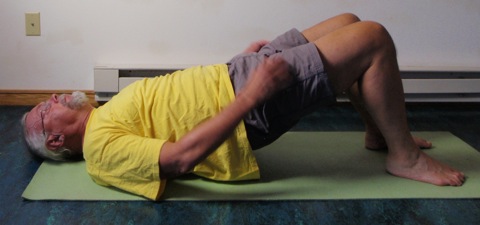
Finish of the bridging core training |
| Single Leg Bridging: Lie on your back on the floor with your knees bent and your feet flat on the floor near your butt. Tighten your core muscles and lift your right leg off the floor; we’ll work the left glute first. Tighten your left glute (butt muscle) to raise your butt about 8 to 12 inches off the floor and lower. One rep is to lift foot, raise butt, lower butt and lower foot. (You can make this harder by not lowering your foot in between.) Alternate sets of left and right legs. Three sets of 10 to 20 reps. |
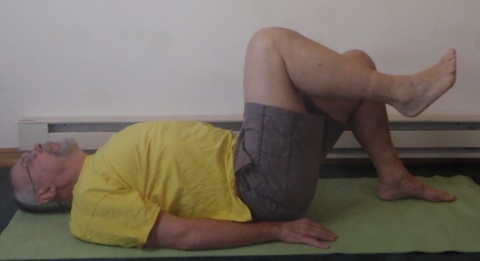
Start of single leg bridging
training. Abdominal muscles engaged
to stabilize core. |
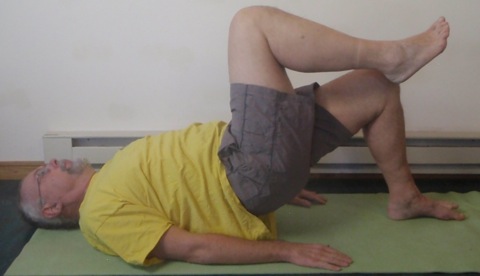
Finish of single leg bridging.
|
| Lying Back Extension: Start by lying on your stomach on the floor, arms extended along the floor above your head. Tighten your abs and back so that your pelvis is in neutral and doesn’t move. Raise left arm and right leg until slightly off the floor, hold 3-5 seconds and lower. Then the right arm and left leg. The key is to hold your core muscles tight and immovable while you do the alternate raises. Three sets of 10 to 20 reps. |

Start of the lying back extension
exercise. |

Finish of lying back extension. |
| Kneeling Back Extension: Start with your hands and knees on the floor. Tighten your abs and back so that your pelvis is in neutral and doesn’t move. Raise right arm and left leg, hold 3-5 seconds and lower. Your back should not move—just like a table. Repeat with left arm and right leg. Three sets of 10 to 20 reps. |
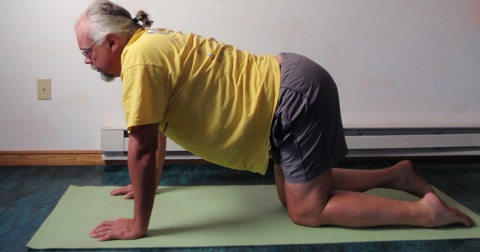
Start of kneeling back extension core
exercise. Abdominal muscles engaged
to stabilize core. |
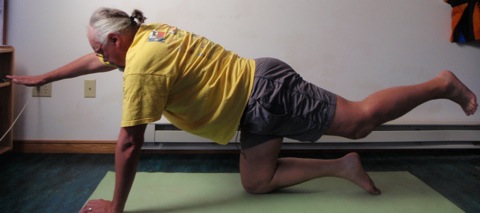
Finish of kneeling back extension. |
| Plank: Lie prone on your front on the floor with your toes bent and resting on the floor. Your elbows are bent resting on the floor under your shoulders with your forearms extended along the floor to form a V with your hands together under your head. Tighten your core muscles to raise all of your body off the floor except for your toes, elbows, arms and hands. Use your core muscles, not your surface abs and back muscles. Three reps of 30+ seconds. Increase by 5 seconds each week. Rest an equal amount of time between reps. |
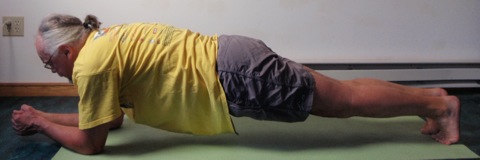
The plank. Abdominal muscles
engaged to stabilize core. |
|






























